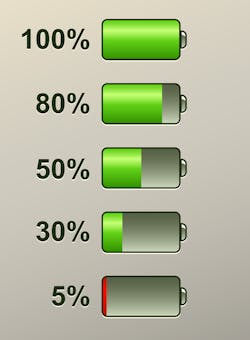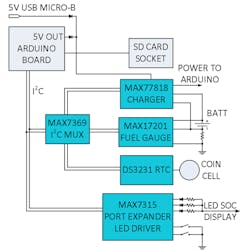Advanced Battery Management for the Rest of Us
Download this article in PDF format.
Battery management, like military radars and supersonic jets, is a sophisticated technology that’s been out of reach for engineers who don’t have special clearance or deep pockets—until now.
Charging and fuel gauging—at the heart of every battery-management system—are critical components of any mobile or IoT application. Battery performance relies on a high-quality battery model to drive the fuel-gauging algorithm. Extraction of the right model for the chosen battery is difficult, expensive work. In fact, only a few large manufacturers have the resources to develop such models.
The accessibility of accurate models can be a huge barrier to the proliferation of low-volume portable applications. This article presents a disruptive approach to cracking the battery-management barrier with a quick, cost-effective, high-performance solution.
Fuel Gauging for the Few
The release of energy from a battery adds up to nothing less than a controlled explosion. The energy stored in the battery (capacity) depends on load and temperature. Hence, developers recognize the importance of characterizing the battery under various conditions. Once a model tuned to the battery behavior is extracted, it’s loaded into the fuel-gauge chip. This closely supervised process results in accurate gauging and safe battery charging and discharging.
1. It can be time-consuming to maximize battery performance and minimize the state-of-charge (SOC) error while correctly predicting if the battery is nearly empty.
IC vendors have traditionally focused on high-volume applications, since a few weeks of lab work are necessary for model extraction. This time-consuming, customized work yields maximum battery performance, in cases such as minimizing the state-of-charge (SOC) error and correctly predicting if the battery is nearly empty. Figure 1 illustrates a battery SOC.
Fuel Gauging for the Many
By studying the characteristics of common lithium batteries, it’s possible to develop an algorithm capable of handling the majority of these batteries. Such an algorithm can use a battery model tuned to the specific application and be embedded into the fuel-gauge ICs. Subsequently, designers are able to generate the battery models themselves using a simple configuration wizard included in the evaluation kit software. The system designer needs to provide only three pieces of information:
1. Capacity (often found on the label or datasheet of the battery)
2. The voltage per cell, considered the empty point for the battery (application-dependent)
3. Whether the battery-charge voltage is above 4.275 V (per cell, in case of multiple series cells)
With such an algorithm, the system designer’s characterization work, already performed by the manufacturer, essentially disappears. Assuming a system error budget of 3% in the prediction of the SOC, the algorithm’s model should cover 97% of the test cases.
In addition, the algorithm should include several adaptive mechanisms that help the fuel gauge learn about the battery characteristics to improve its accuracy even more. One such mechanism guarantees that the fuel-gauge output converges to 0% as the cell voltage approaches the empty voltage, thus reporting 0% SOC at the exact time that the cell voltage reaches empty.
For many users, just knowing SOC or remaining capacity (mAhr) isn’t sufficient. They really want to know how much run-time they can get out of the residual charge. Simplistic methods such as dividing the remaining capacity by the present or future load can lead to unrealistically optimistic answers. The proposed algorithm should come to the rescue, providing an accurate time-to-empty register based on battery parameters, temperature, and load effects, as well as the empty voltage of the application.
The proposed algorithm’s advantages are obvious. High-volume manufacturers can use it as a starting point to get development going even before selecting the right battery for the application. They can then turn to a finely tuned battery model at a more mature stage of the development. The small-volume manufacturer can use it to define the model of the battery and run with it, having the confidence that most batteries out there will be compatible.
Such an algorithm is built into ModelGauge m5 EZ ultra-low power, stand-alone fuel-gauge ICs developed by Maxim Integrated.
Fuel Gauging for All
2. The MAXREFDES96 is configured using an I2C interface.
A logical next step to simplify a battery system’s design is to put it on an Arduino form factor shield (Fig. 2). Maxim’s MAXREFDES96 IoT Power Supply is an Arduino form factor shield, powered by a 660-mAh Li-ion battery for running an untethered Arduino system (Fig. 3). The design features both of Maxim’s battery-management technologies: a highly integrated battery charger and a ModelGauge m5 EZ fuel gauge. Additional Maxim devices provide system-management and power-supply functions.
3. The MAXREFDES96 is an Arduino Uno R3-compatible board that provides battery charge, boost and data-logging capabilities.
These technologies boost charging and improve the accuracy of battery-capacity feedback to help maximize performance. The MAXREFDES96 may be charged through the host board USB connector, the host board power adapter, or via the on-board power connector. Furthermore, the system accommodates any single cell Li-ion battery, allowing for development with batteries of different sizes from different manufacturers. Free firmware supports operation with Arduino and mbed.org platform boards.
With the MAXREFDES96, the battery model can be directly stored in nonvolatile memory on the MAX17201, or on the Arduino board. In the latter case, the models are transferred from the board to the shield at power up. This arrangement allows for the use of a variety of batteries. And with the Arduino platform, many available software drivers can be employed.
An untethered Arduino board is appealing to an extended range of applications and users, including hobbyists and enthusiasts. The system can be leveraged for its portability and deployed in a remote location for data gathering; for its transportability by moving a running test between locations without interruption; or as a backup system in case the main power fails at a critical time of the development. In all cases, the system facilitates battery management, leading to quicker charging, more accurate fuel gauging, and longer battery life.
Conclusion
We have highlighted the critical importance of battery modeling for an effective fuel gauge system, and discussed the barriers to obtain these models that impedes the proliferation of low-volume battery applications. A disruptive approach, based on the ModelGauge m5 EZ algorithm and the MAXREFDES96 Arduino shield, helps simplify and lower the cost of battery-system implementation—and is available to all.
About the Author
Bakul Damle
Business Director of Battery Management, Mobile Group
Business Director of Battery Management for the Mobile Group, Bakul Damle’s current interests include battery and power management specifically in fuel gauges, battery charging, energy harvesting, wireless charging, and battery authentication. He joined Maxim in 2005 and is based in Dallas, Texas.
Nazzareno Rossetti
PhD EE
Nazzareno (Reno) Rossetti, a PhD EE at Maxim Integrated, is a seasoned analog and power-management professional, a published author, and holds several patents in this field. He holds a doctorate in Electrical Engineering from Politecnico di Torino, Italy.




